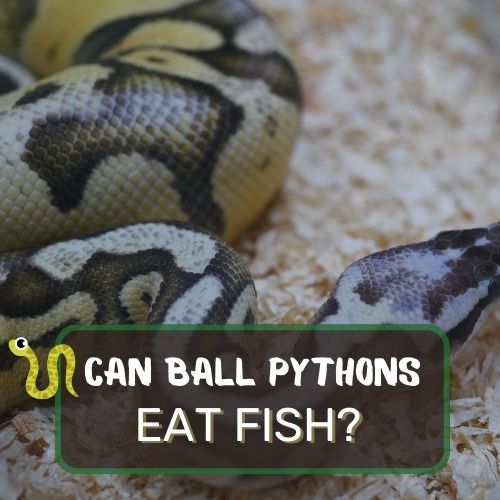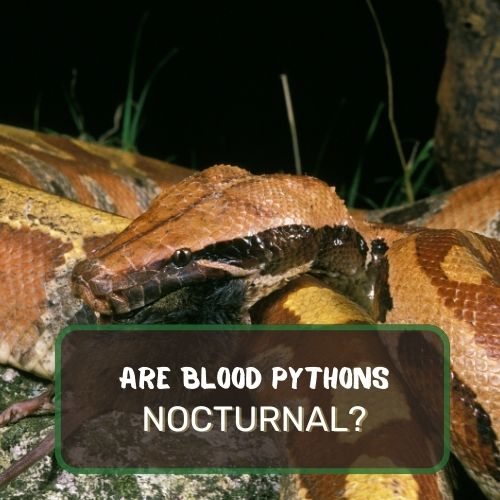
Have you ever wondered, “Can ball pythons eat fish?”
It’s a question that many snake enthusiasts and pet owners grapple with, especially when trying to diversify their python’s diet.
In this article, we delve deep into the dietary habits of ball pythons, exploring their natural preferences and the potential risks and benefits of introducing fish into their meals.
Drawing from scientific research, expert opinions, and the python’s evolutionary history, we aim to provide a comprehensive answer.
By the end of this read, you’ll have a clear understanding of what’s best for your slithering companion, ensuring their health and happiness for years to come.
Dive in and discover the fascinating world of ball python nutrition!
Table of Contents
Do Ball Pythons Eat Fish?
Ball pythons can eat fish, but it’s not a primary or preferred food source for them. In their natural habitat, these snakes primarily consume rodents, such as mice and rats. While fish are high in protein and can be consumed by ball pythons, it’s essential to ensure the fish doesn’t contain harmful enzymes like thiaminase, which can lead to Vitamin B1 deficiency in the snake.
If a ball python owner chooses to offer fish, it should be an occasional treat rather than a staple. Moreover, many pythons might even refuse fish, showing a clear preference for warm-blooded prey.

Ball Python’s Natural Diet
When you think of the vast African grasslands, images of lions, elephants, and gazelles might come to mind.
But lurking in the underbrush, hidden away from the blazing sun, is the ball python, a creature with its own set of dietary preferences and needs. Let’s embark on a journey to understand what fuels these intriguing reptiles.
What Ball Pythons Eat in the Wild
In the wild expanses of West and Central Africa, ball pythons aren’t feasting on a buffet of varied foods. Instead, they have a rather specific menu.
Their primary choice? Rodents. Whether it’s a scurrying mouse or a slightly larger rat, these reptiles have honed their hunting skills to target these warm-blooded creatures.
Occasionally, when the opportunity presents itself, they might snag a bird, but rodents remain their primary prey.
The Importance of Understanding Their Natural Diet
Now, you might wonder, “Why does it matter what they eat in the wild? I can just feed them whatever’s available at the pet store.” Well, understanding a ball python’s natural diet is paramount for several reasons.
Firstly, it ensures their health and longevity. Just as humans can’t thrive on junk food alone, ball pythons need a diet that mirrors what they’d consume in their natural habitat to remain healthy. Secondly, it affects their behavior.
A well-fed python, given a diet that aligns with its natural preferences, is likely to be more active, more responsive, and less prone to health issues.
Evolutionary Preference for Warm-Blooded Prey
Evolution is a fascinating thing. Over millennia, ball pythons have evolved specific hunting mechanisms tailored to catching warm-blooded prey.
From their heat-sensitive pits that detect the body heat of rodents to their powerful constriction method, everything about them screams “rodent hunter.”
This evolutionary preference isn’t just a quirky fact; it’s a testament to the importance of feeding them the right kind of food.
Offering them cold-blooded prey, like fish, goes against this evolutionary grain, potentially leading to dietary and health issues.

Risks of Feeding Fish to Ball Pythons
Nutritional Imbalances and Deficiencies
Diving into the world of reptile nutrition can be a bit like navigating a maze. Each species has its unique dietary needs, and ball pythons are no exception.
While fish might seem like a nutritious option at first glance, they can lead to nutritional imbalances when fed to ball pythons.
For instance, certain fish can cause a Vitamin B1 (thiamine) deficiency due to an enzyme they contain called thiaminase. This deficiency can wreak havoc on a python’s nervous system, leading to a host of health issues.
Moreover, fish lack some of the essential nutrients that ball pythons derive from their primary diet of rodents. It’s a bit like us trying to survive solely on salad – it might seem healthy, but it won’t provide all the nutrients we need.
Potential Health Risks and Concerns
Beyond nutritional deficiencies, there are other health risks associated with feeding fish to ball pythons. Some fish, especially if not sourced or prepared correctly, can harbor parasites or toxins.
Imagine the horror of unknowingly feeding your beloved python a parasite-infested fish!
Additionally, as we touched upon earlier, the thiaminase enzyme found in certain fish can lead to Vitamin B1 deficiency, which can have severe consequences, including nervous system problems.
The Difference Between Feeding Fish Occasionally vs. Regularly
Now, you might be thinking, “What if I just give my python fish as a treat once in a while?” Well, there’s a significant difference between an occasional fishy treat and making fish a regular part of their diet.
Offering fish sporadically, especially if it’s a type that’s safe for pythons, might not cause immediate harm. However, regular fish feedings can lead to the aforementioned health issues and nutritional imbalances.
It’s a bit like indulging in junk food now and then versus eating it every day. The occasional treat might not hurt, but regular indulgence can lead to health problems.
The idea of diversifying your ball python’s diet might seem appealing, it’s essential to approach it with caution and knowledge. Their evolutionary and biological needs point towards a rodent-rich diet.
As dedicated snake parents, it’s our responsibility to ensure they get the best, most appropriate food for their well-being. So, before you consider dropping that fish into their terrarium, remember the risks and opt for a juicy mouse instead.
What Fish Can You Feed a Ball Python?
Navigating the fish aisle for your ball python? It’s not as straightforward as you might think. While ball pythons can technically consume fish, not all fish are created equal in the eyes (or rather, the stomach) of a python.

Discussing the Types of Fish That Might Be Safer for Ball Pythons
If you’re adamant about giving your python a fishy treat, there are a few options that might be safer.
Fishes like salmon, guppies, trout, and platies are considered to have lower levels of thiaminase enzyme, which, as we discussed earlier, can lead to Vitamin B1 deficiency in pythons.
However, it’s crucial to avoid fishes like rosy reds, minnows, goldfish, mackerel, or whitebait, as these can be harmful to your slithering friend.
Emphasizing the Importance of Variety and Moderation
Variety is the spice of life, but when it comes to your ball python’s diet, moderation is key. Even if you’re feeding them the “safer” fish options, it’s essential to do so sparingly. Think of fish as the occasional treat, not the main course.
And always ensure that the fish is fresh, free from toxins, and sourced from reliable places.
Preferred Foods for Ball Pythons
When it comes to the culinary preferences of ball pythons, they’re pretty traditional. They like what they’ve evolved to eat, and that’s primarily warm-blooded prey.

Warm-Blooded Prey Like Rodents and Birds
Mice, rats, and sometimes small birds top the list of ball python favorites. These warm-blooded creatures align perfectly with the python’s natural hunting mechanisms, from their heat-sensitive pits to their powerful constriction method.
It’s like a match made in reptilian heaven!
The Benefits of Sticking to Their Natural Diet
There’s a reason nature designed ball pythons to feast on rodents. This diet provides them with all the essential nutrients they need to thrive. It supports their growth, ensures a robust immune system, and keeps them active and healthy.
Plus, a diet that mirrors their natural prey can also lead to more predictable and stable behavior, making them easier to handle and care for.
Addressing Common Misconceptions
There’s a lot of information (and misinformation) out there about what to feed your ball python. Some might say, “A little fish won’t hurt,” or “They get bored with the same food.” But remember, ball pythons aren’t like us.
They don’t crave variety in the same way. They don’t get “bored” with their food. They need consistency, and they need a diet that aligns with their biological and evolutionary needs.
So, the next time someone suggests a fish feast for your python, you’ll be armed with the knowledge to make the best decision for your scaly companion.

How Often Should You Feed Your Ball Python?
Feeding your ball python isn’t just about what you offer them; it’s also about how often. Just like us, these reptiles have their own dietary rhythms, and understanding them is crucial for their well-being.
Let’s delve into the world of python feeding schedules and the factors that influence them.
Discussing Feeding Frequency
Ball pythons, unlike us humans who might snack multiple times a day, have a slower metabolism. This means they don’t need to eat as frequently as we do.
Typically, baby ball pythons should be fed once a week, while adult ball pythons can be fed once every two weeks.
This schedule ensures they get the nutrients they need without overfeeding, which can lead to obesity and other health issues.
Factors That Influence How Often You Should Feed Them
Several factors can influence a ball python’s feeding frequency:
- Age: Younger pythons, still growing and developing, require more frequent feedings compared to their adult counterparts.
- Size of the Prey: If you’re offering a larger meal, you might want to space out feedings a bit more. Conversely, smaller prey might necessitate slightly more frequent feedings.
- Activity Level: A more active ball python might require more energy and, therefore, more frequent meals.
- Health and Weight: If your python is underweight or recovering from an illness, more frequent feedings might be beneficial. Conversely, an overweight python might benefit from a reduced feeding schedule.
- Shedding Cycle: Pythons often lose their appetite during their shedding cycle. It’s not uncommon for them to skip a meal during this period.

Final Word
You’ve journeyed through the intricate world of ball python nutrition, unraveling the age-old question: can ball pythons eat fish?
As you’ve discovered, while these captivating creatures can technically consume fish, it’s not their primary or preferred food source.
Nature, in its infinite wisdom, has designed ball pythons to thrive on a diet rich in warm-blooded prey, primarily rodents. This evolutionary choice ensures they receive all the vital nutrients they need to lead a healthy, active life.
Feeding your ball python isn’t just about providing sustenance; it’s about understanding and respecting their natural dietary needs.
By aligning their meals with their evolutionary preferences, you’re not only ensuring their physical well-being but also promoting their overall happiness.
Remember, every choice you make for your python reflects your commitment and love for them. Continue to educate yourself, seek expert advice, and always prioritize their well-being.
Your ball python is more than just a pet; they’re a testament to the wonders of nature. Keep up the fantastic work, and here’s to many joyful years with your slithering companion!
Frequently Asked Questions
Navigating the dietary needs of ball pythons can be a maze of questions. Here, we’ve compiled some of the most commonly asked questions to help guide you through the world of ball python nutrition.
What Fish Can You Feed a Ball Python?
While fish isn’t a staple in a ball python’s diet, if you choose to offer it occasionally, opt for fish like salmon, guppies, trout, or platies. These are considered to have lower levels of harmful enzymes like thiaminase. However, always ensure the fish is fresh and sourced from reliable places.
What Can Ball Pythons Not Eat?
Ball pythons should avoid certain types of fish like rosy reds, minnows, goldfish, mackerel, and whitebait due to potential harmful enzymes. Additionally, any food that’s too large or not part of their natural diet, like large birds or other reptiles, should be avoided.
What is a Ball Python’s Favorite Food?
Ball pythons have a strong preference for warm-blooded prey. In the wild, they primarily feast on rodents, such as mice and rats. These provide the essential nutrients they need and align with their natural hunting mechanisms.
Can Ball Pythons Eat Goldfish?
It’s best to avoid feeding goldfish to ball pythons. Goldfish can contain thiaminase, an enzyme that breaks down Vitamin B1, leading to potential health issues for the python. Stick to safer fish options or, better yet, their natural preference of rodents.




0 Comments